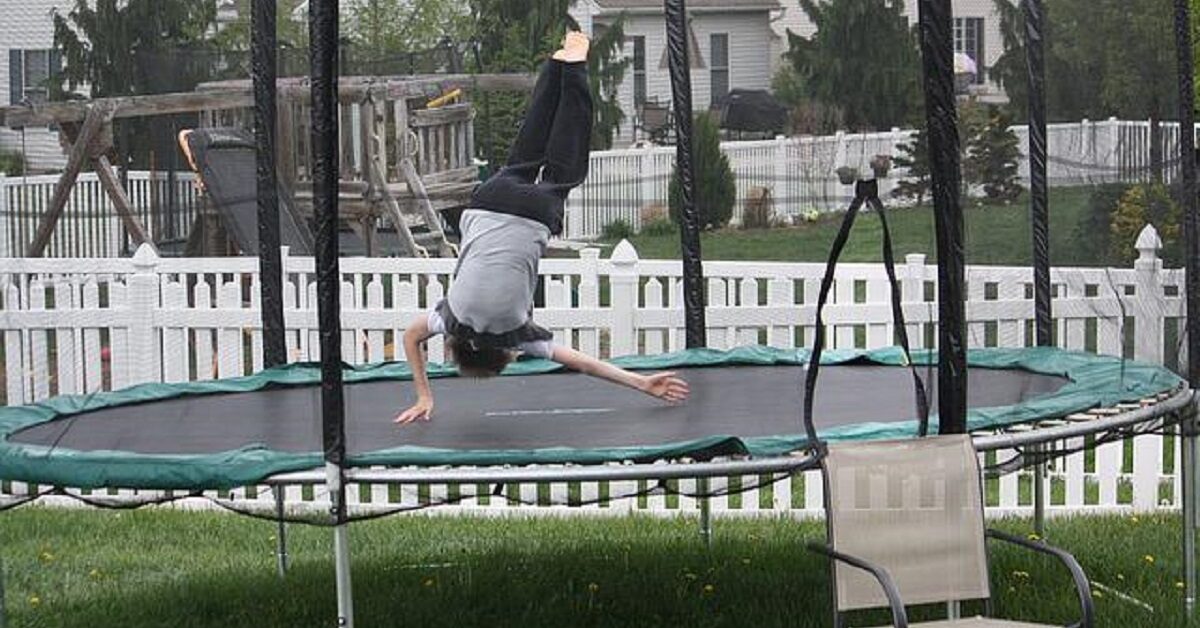
If you do trampoline exercise or rebounding for recreation or sports, you may have wondered how many calories jumping on a trampoline burns?
This article answers all your questions and more.
You may use our Calories Burned Calculator (view the calculator here) to estimate energy expenditure associated with rebounding on a trampoline.
How many calories you burn by jumping on a trampoline or mini-trampoline depends on many factors. The factors include duration, activity intensity, age, sex, weight, lean body mass, and height.
Individuals with a higher lean mass burn more calories than others of the same weight, age, and sex.
The ability of our calculator to take account of relevant factors that affect energy expenditure means that it offers individualized estimates.
But remember that a calculator only gives rough estimates of calorie expenditure associated with physical activity.
You may get more accurate estimates using indirect/direct calorimetry and heart rate monitoring.
Contents:
Calories Burned Calculator: Trampoline or rebounder
Trampoline for cardiorespiratory fitness
Trampoline sports or gymnastics
What is the Standard MET of trampoline exercise?
How to calculate calories burned jumping on a trampoline
Calories Burned Calculator: Trampoline or rebounder

Our Calories Burned Calculator returns individualized estimates of energy expenditure while exercising on a trampoline or rebounder. The computation makes use of ALL the information you enter.
Our calculator also corrects for the effects of high lean body mass.
Athletes and bodybuilders with high lean body mass and high body mass index (BMI) (view our BMI calculator here) may chose an option that approximates their body fat percentage from the drop-down menu provided.
You may learn about how our calculator estimates calories burned here.
An average 21-year-old male standing 5 feet 10 inches tall (177.8 cm) and weighing 71 kilograms burns 43.5 calories rebounding with moderate intensity for 10 minutes.
The same young male burns 55.9 calories while exercising with vigorous intensity for 10 minutes.
An average 21-year-old female standing 5 feet 5 inches tall (165.1 cm) and weighing 55 kg (121.254) burns 33.7 calories exercising on a trampoline with moderate intensity for 10 minutes.
She burns 43.3 calories exercising with vigorous intensity for 10 minutes.
Health benefits of rebounding

Trampoline exercise — also known as trampolining or rebounding — is a low-impact aerobic exercise. A trampoline has an elastic fabric secured at the sides, usually on a steel frame.
Small-sized trampolines (mini-trampolines) have also become popular. Rebounders are more portable versions of standard trampolines.
Rebound exercise involves bouncing and jumping on the canvas fabric while performing twists and somersaults. You may also do jumping jacks, walking movements, jogging, running, dance, and acrobatics.
The intensity of aerobic activity on a trampoline may vary from light to moderate and vigorous.
Moderate and vigorous trampolining increases heart rate and oxygen consumption. It engages the large muscles and may help strengthen the skeletal frame by improving bone density.
It also burns lots of calories and thus helps in weight loss.
Trampolining is a low-impact aerobic exercise. That means it is gentle on the joints. That makes it a viable alternative to high-impact aerobics, such as running, jogging, and jumping on hard ground.
Rebound exercise may also improve motor skills, balance, and coordination.
Some of the muscles activated by trampoline exercise include:
- Legs muscles (thighs and calves)
- Buttock muscles
- Hip and waist
- Abdominal and core muscles
Trampoline health benefits

The U.S. milliary recognized the aerobic exercise value of trampolining during World War II.
It was used during the war to train pilots in balance and spatial awareness (Burandt et al., 2016; Esposito and Esposito, 2009).
NASA also explored using trampolines to train astronauts for spatial orientation skills. Researchers working with the space agency reported that rebounding was as effective as other aerobic exercises, such as running (Bhattacharya et al., 1978) .
Bhattacharya and associates (1978) conducted a study to compare the effects of jumping on a trampoline at four heights with walking on a treadmill at four speeds.
They concluded that at comparable levels of heart rate (HR) and oxygen consumption (VO2), jumping exerted more biomechanical stimuli than running.
The study suggested that trampolines may play a role in aerobic exercise conditioning of astronauts who have experienced weightlessness.
The experience of weightlessness due to space microgravity has profound physiological implications.
Astronauts experience deconditioning of the skeletal and heart muscles due to prolonged exposure to weightlessness in space (Tanaka et al., 2017).
Cardiovascular deconditioning occurs during prolonged space flights. It involves atrophy of the heart muscles, decreased blood volume, and multiple hemodynamic changes that alter overall cardiac function (Gallo et al., 2020) .
Deconditioning may also involve atrophy of the skeletal muscles (especially the leg muscles) and associated loss of bone mineralization.
Rebounding vs. running

McGlone and associates (2002) reportedly found no significant differences in maximal heart rate (HRmax), maximal oxygen uptake (VO2max), and total calories burned between working out on a mini-trampoline and running on a treadmill.
According to the researchers, rebounding provided adequate stimulus to improve and maintain cardiovascular fitness. They recommended it for people seeking a low-impact alternative to traditional aerobic exercises, such as brisk walking, jogging, and running.
However, a study by Edin and associates (1990) appeared to not support the conclusions by Bhattacharya and associates that trampolining may be as health-promoting as running.
Rebounding for weight loss

Edin and colleagues (1990) investigated the effect of regular rebound exercise on cardiorespiratory fitness, body composition, and blood lipid levels in 17 women.
The women exercised on mini-trampolines for two 15-minute periods (with 5 minutes of rest between the periods) 5 days a week for 11 weeks. The exercise intensity was sufficient to achieve prescribed minimum heart rates.
After 11 weeks, the researchers reported only a 4.4% improvement in V02max for the rebounders. They found no difference in weight, body fat percentage, and total HDL cholesterol/ triglyceride levels between the mini-trampoline users and a control group.
The control group consisted of sedentary women who did not engage in trampoline exercise.
The researchers concluded that 11 weeks of rebounding exercise resulted in minimal improvements in cardiorespiratory fitness. There were no significant changes in other measures of health.
But Edin and colleagues noted that more research was needed to explore the potential benefits of rebounding for people who need low-impact alternatives to high-impact aerobic exercises.
However, other studies reported positive results.
Cugusi and colleagues (2018) conducted a study to evaluate the health and weight loss benefits of mini-trampoline rebounding exercises.
Following trials involving 18 women, the researchers reported that measures of body composition improved significantly after 12 weeks of trampoline exercises.
The measures included circumference, fat mass, and lean body mass,
They also reported significant improvement in systolic and diastolic blood pressure (128/80.5 to 123/71 mmHg). They reported improvements in lipid and glucose levels and increases in VO2max.
They concluded that trampoline exercise improved the health of the subjects and that it may be beneficial for overweight women.
Trampoline for lymph health

Multiple research studies suggest that aerobic exercise may help improve lymphatic system function and reverse pathological changes in lymphatic endothelial cells (Hespe et al., 2016).
The lymphatic system consists of vessels and nodes that serve as the drainage system for lymph (lymphatic fluid).
Studies indicate that exercise helps lymph move better through the lymphatic vessels and reduces swelling (lymphoedema).
The lymphatic system is part of the immune system. The lymph nodes contain lymphocytes, such as B-and T-cells, also known as white blood cells.
Lymphocytes are special immune cells that kill pathogens (harmful bacteria and viruses) and remove cancerous cells. The nodes also act as filters that sieve toxic and waste products from the body.
Lymph is derived from interstitial fluid but drains back into the bloodstream.
[Note: Interstitial fluid comes from tissue and cells, including the blood capillaries. It collects in the spaces between the cells.]
The lymphatic system relies on the contraction of muscles to move lymph fluid through the vessels. Exercise helps improve lymph drainage because muscle contraction squeezes vessel walls.
The research evidence on the role of exercise in improving lymph flow has led health experts to suggest that trampoline exercise may improve lymphatic function in sedentary individuals.
Obese individuals and people who live a sedentary lifestyle have an increased risk of health problems due to poor lymph flow.
Poor lymph flow causes a build-up of toxic products and an associated increased risk of cancer.
Advocates claim that jumping on a mini-trampoline may help stimulate lymph flow through the lymphatic system.
Trampoline exercise may also help in weight loss, a factor in lymphatic system dysfunction.
Trampoline for cardiorespiratory fitness

Gerberich and associates (1990) investigated the effects of mini-trampoline exercise on sedentary women. The women performed jogging-step and bouncing exercises on trampolines.
The researchers concluded that bouncing on a rebounder was less effective than jogging-step exercise on a rebounder.
Bouncing was less effective for raising heart rates, VO2, and energy expenditure. It was also less effective than running exercise on a treadmill.
The conclusion appeared to be partly in conflict with the results by Bhattacharya and associates (1978).
Burandt and associates (2016) conducted a study to determine whether the intensity of workout on a mini-trampoline satisfied ACSM recommendations for cardiorespiratory fitness.
[Note: ACSM guidelines recommend moderate-intensity aerobic activity for at least 30 minutes, 5 days/week. The guidelines also recommend vigorous-intensity activity for at least 20 minutes, 3 days/week.]
The study involved 24 healthy subjects who exercised a minimum of 3 times/week. They performed 19-minute exercise routines on mini-trampolines.
The researchers found that the heart and oxygen consumption rates achieved at moderate and vigorous-intensity levels of exercise met the ACSM guidelines for improved cardiorespiratory fitness.
The results suggested that trampoline aerobic exercise may be an effective alternative to running or exercising on a treadmill. Rebounding may also be suitable for individuals who need an alternative to high-impact aerobic exercises.
Trampoline sports or gymnastics
Trampolining emerged as a sport in the 20th century.
The first official American trampolining championships took place in 1954. Trampolining competition also featured in the Pan-American Games the following year.
The premiere trampoline World Championship was held in London in 1964. It followed the first open international event in West Germany in 1962.
The success of the events spurred the establishment of the International Trampoline Association in 1964.
The sports first featured at the Olympic Games in Sydney in 2000.
Trampoline injury risks

The increasing use of trampolines for recreational has led to an increase in reported incidents of trampoline-related injuries, especially among children (Furnival et al., 1999; Esposito and Esposito, 2009).
People use trampolines and mini-trampolines in private residences, schools, outdoor playing grounds, and gym clubs.
The U.S. Consumer Product Safety Commission estimated that hospitals treated more than 300,000 trampoline-related injuries in 2018 alone.
Health experts warned about the significant risks for young children due to trampolines.
Alberta Health Services (AHS) reported that trampoline-related injuries may cause permanent disability and even death.
The most commonly reported injuries include:
- Cuts, sprains, and bruises
- Fractures (leg, shoulder, and arm fractures)
- Dislocations (ankle and feet dislocations)
- Head, neck, back trauma, and injuries may sometime cause paralysis or death
Children suffer about 90% of trampoline-related injuries. The age group with the highest injury rates were children aged 5 to 9 years old.
The AHC noted that most trampoline-related injuries in children were not due to falling off the device. Injuries due to falling off were less than 30 percent of total reported cases (2013-2015).
Thus, providing trampolines with guards did not sufficiently reduce injury rates. Injury rates remained significant even in trampolines with guards to prevent users from falling off.
More than three-quarters of accidents that resulted in injuries were due to children colliding while jumping on the device together. Some were due to a child user falling on the device frame or springs. Others occurred when a child jumped and landed incorrectly on the mat.
Injuries also occurred due to falls resulting from high-flying or poorly coordinated acrobatic maneuvers.
The high rates of trampoline-related injuries among children led the U.S. and Canadian health authorities to warn that trampolining was a high-risk activity for children.
According to health authorities, parents should avoid installing trampolines at home because they are not safe for children.
Children younger than 6 years should never use a trampoline for play.
Older children may use trampolines only under careful adult supervision.
Calories burned formula
Our calculator estimates your calorie expenditure by using the following equation:
Calories burned/minute = Standard MET x 3.5 ml/kg/min x Weight (kg)/200
You may learn more about the equation here.
What is the Standard MET of trampoline exercise?

The Compendium of Physical Activities assigns the following MET values to trampoline based on the intensity of the exercise
| Compendium Code | Activity | MET value |
| 15700 | sports trampoline, recreational | 3.5 |
| 15702 | sports trampoline, competitive | 4.5 |
How to calculate calories burned jumping on a trampoline
Example 1:
Estimate calories burned by a 21-year-old woman jumping with moderate intensity for recreational purposes if she jumps continuously for 10 minutes.
[Additional information: The subject is 65 inches (165.1 cm) tall and weighs 55kg (121.254lbs).]
Solution:
Calories burned/minute = Standard MET x 3.5 ml/kg/min x (weight in kilograms)/200
The Standard MET of recreational exercise on a trampoline is = 3.5 METs (see table above)
Calories burned = 3.5 x 3.5 x 55/200 = 3.36875 calories per minute
Calorie expenditure in 10 minutes = 33.69 calories
Example 2:
Estimate calories burned by the young subject in Example 1 if she engages in the same activity with vigorous intensity for 10 minutes during a competitive event.
Solution:
Calories burned per minute = Standard MET x 3.5 ml/kg/min x (weight in kilograms)/200
Standard MET of competitive trampolining = 4.33 (see table above)
Energy expenditure per minute = 4.5 x 3.5 x 55/200 = 4.33 calories
Energy expenditure in 10 minutes =4.33 x 10 = 43.3 calories.

